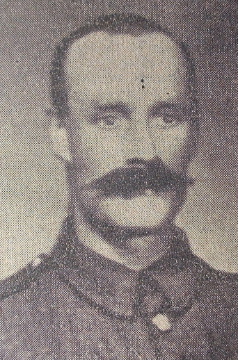Private
John William Asnip
7164 2nd East Lancashire Regiment
Killed in Action 11th March 1915,
in France
Lived at 8 Lisbon St.
Commemorated on the Le-Touret
Memorial, France
Commemorated on the Holy
Trinity Memorial
Burnley Express 27th
March 1915
John
was a time expired soldier who had served in the Boer War
which he had escaped unscathed, earning the Kings and Queens South
Africa medals with 2 and three three clasps respectively.
After leaving the army he was employed as a pit top worker at Bank Hall
where he worked for 13 years before volunteering at the outbreak of
war.
He arrived at the front in September 1914 and regularly sent letters
home,
until a photograph of his wife which he had requested was returned with
the note that the soldier could not be found.Later a letter was sent
from
one of his chums informing her of his death.


He was killed alongside James Howley of Brierfield during the battle of Neuve Chapelle when his battalion suffered heavy losses from German artillery fire after having made some headway against the German trenches. On the day he died the battalion had 7 officers and 70 other ranks killed, with 8 officers and 182 other ranks wounded (in addition to 23 men missing) . His name is incorrectly recorded as Aspin on the Holy Trinity Memorial.
AFTER 16
YEARS SERVICE
KILLED BY A SNIPER, NEWS OF A BURNLEY MAN (Burnley
Express 24/3/1915)
A letter
home, sent by a Burnley soldier named Clarke, contains news of the death
of his regimental chum, Pte. J.W. Asnip of 8 Lisbon-street, Burnley
and says that he was killed by a German sniper.
Pte. Asnip had completed 16 years service in the Army and volunteered,
and was accepted for service when the war commenced. He had a proud
Army record.
When the Boer War broke out he was serving in India, where he had been
seven years and he had earned a badge for a skirmish near Paard and
along with his regiment the 2nd East Lancashires was sent to the front
early on. He took part in the big engagements and at the end of the
war, through which he passed without injury was given the King’s
and Queen’s medals with three and two clasps respectively.
Returning from Africa, Asnip became employed as a pit top worker at
Bank Hall and he was still employed there after 13 years continuous
service when he left for France in August. He got to the firing line
with the East Lancashires early in September and letters were received
from him more or less regularly up to some five weeks ago when a photograph
of his wife, which at his own request had been sent out to him, was
returned with the information that the soldier could not be found. Nothing
further was heard until Pte. Clarke’s message arrived on Sunday.
The dead soldier was very well known in the Sandygate district, and
was a general favourite with the workmen at Bank Hall.
It is interesting to note that three other members of the Asnip family
have served in the colours, two in the East Lancashires and one in the
Scottish Borderers.